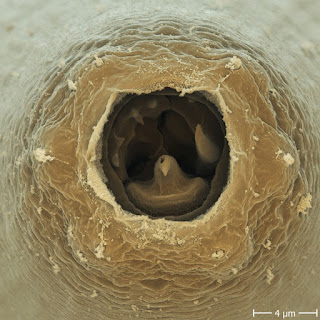I always thought mass social behavioral modification would be via olfactory receptor manipulation, but this looks like another option:
Controlling nematode worm behavior using two different light-sensitive proteins called opsins*
Nov 2022, phys.org
So they are "introducing" new sensory cells into the C. elegans. They find light-sensitive cells (opsins) in other animals, and put them in the worms.
One opsin is sensitive to white light and comes from a mosquito, another is sensitive to ultraviolet light and comes from a lamprey. These "tuned" light-receptor cells are then introduced to parts of the worm's motor neurons.
When you shine light on the worm, it stimulates the motor neurons, making them move. They made the white-light opsins to make the worm go, and the UV light makes it stop.
They can then move the worm, or rather make the worm move itself, by shining light on it. Fuck off.
*Opsins, like olfactory receptros, are GPCR's -- G protein-coupled receptors
via Graduate School of Human Life and Ecology at Osaka Metropolitan University: Mitsumasa Koyanagi et al, High-performance optical control of GPCR signaling by bistable animal opsins MosOpn3 and LamPP in a molecular property–dependent manner, Proceedings of the National Academy of Sciences (2022). DOI: 10.1073/pnas.2204341119
Scientists create living smartwatch powered by slime mold
Dec 2022, phys.org
Using the electrically conductive single-cell organism known as "slime mold," the researchers created a watch that only works when the organism is healthy, requiring the user to provide it with food and care.The organism (Physarum polycephalum or slime mold) is placed in an enclosure on the watch, and the user must regularly feed it a mixture of water and oats to induce its growth. When the slime mold reaches the other side of the enclosure, it forms an electrical circuit that activates the heart rate monitor function. The organism can also enter a dormant state when not fed, allowing for revival days, months, or even years later.The researchers found a high level of attachment to the watch, with some users saying it felt like a pet -- even naming it, or putting their partner in charge of the feeding when they got sick.
via University of Chicago: Jasmine Lu et al, Integrating Living Organisms in Devices to Implement Care-based Interactions, The 35th Annual ACM Symposium on User Interface Software and Technology (2022). DOI: 10.1145/3526113.3545629
Image credit: It's not C elegans but it is a nematode (P pacificus) showing us its teeth. Because it has teeth. Everyday Nightmare Pictures - Nematode Teeth - P pacificus nematode showing its teeth - Jürgen Berger MPI for Biology - 2022


No comments:
Post a Comment